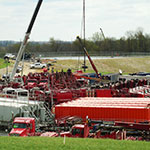Jackpot Junction Casino might seem like just another renovation and addition job, but to Loeffler Construction & Consulting, it’s so much more. The Lakeville, Minnesota-based company recently won the bid to act as construction manager for the $22 million project, and though the work is expected to be challenging, it’s the client that has founders Doug and Tammy Loeffler excited.
The new casino will have a
1,201-slot
gaming floor, a
225-seat
bingo area, a
160-seat
sports bar and entertainment venue, and
20
blackjack tables.
Jackpot Junction is owned by the Lower Sioux Indian Community, and the Loefflers see the facility’s renovation as the start to a long-term relationship. The casino was Minnesota’s first gambling mecca, but the Lower Sioux now face stiff competition. A quality, efficient renovation will help the tribe remain competitive in the industry and recover lost market share.
Loeffler Construction is striving to become the tribe’s builder for all future projects. The company started in 2010, when Doug and Tammy created the business along with two former colleagues, Ben Nordquist and Colin Bigalke. Tammy was already a successful business owner, and Doug served as vice president of operations at JE Dunn Construction. Since 2010, Loeffler Construction has provided various services for other casino and tribal projects, including the Elders Lodge senior-housing facility for Little Earth of United Tribes, and the recent design and construction of the Turtle Mountain Indian Tribe Museum. The company’s experience working on reservation buildings, restaurants, and gaming facilities comes naturally. Tammy, also a court reporter for the Mdewakanton Sioux judicial system, is a member of White Earth Nation and has a passion for supporting Native people and communities.

Jackpot Junction is situated in Morton, Minnesota, where the Lower Sioux community has been pursuing a facility expansion for several years. The project received its funding in 2013, and Loeffler Construction entered a bid along with about six other competitors. “We were the newest and youngest company going up against some major players,” Doug says. “We really scoured the marketplace for good subs—Native American subs—and local contractors.” Using Native American subs not only helped the Loeffler team win the project but will also help those minority-owned companies grow their businesses.
Originally opened as a bingo hall in 1984 and converted to a full casino in 1991, the outdated Jackpot Junction required something new to enhance the experience, wow clients, and attract visitors. The Lower Sioux tribe, along with the design team, design LLC, decided on a completely new casino area with greatly improved indoor air quality, more exciting gaming, and dynamic bars and restaurants. The entire project will take 18 months, during which Loeffler Construction plans to keep the casino operational. “The casino is the primary revenue source for the tribe, and you have to get it done quickly so [that] the new space starts making money for the tribe and its members,” Tammy says.

and Loeffler Construction is also making space
for 1,201 slot machines and 20 blackjack tables. (Rendering: Multivista Construction Documentation)
The task has proven especially difficult so far because the Loefflers’ crew had to remove part of the existing building and create its addition while maintaining the heart and soul of the original casino. First, the company shut down second-floor casino operations to build new offices for management and administrative staff, and in phase two, it completed a second story in the Dakota Exposition Center for suites and a kitchen on the lower level. Then, crews demolished a large portion of the existing building to make way for new construction, which will take approximately one year to complete. A six-month renovation project will follow that.
The new casino will include an LED-illuminated entrance canopy stretching through to the interior and funneling up to a spectacular center bar that will be 60 feet in diameter. Overhead, an illuminated cloud with LED-lit acrylic shelves will help to draw people in. Beyond the new center bar will be a new sports bar, and the project will also include a new bus canopy, more than 1,201 slot machines, blackjack tables, a promotions area, and a bingo space.
60,000 sq. ft.
of Jackpot Junction
Casino’s existing
86,000 sq. ft.
was demolished.
50,000 sq. ft.
is the size of the
new construction.
26,000 sq. ft.
is being remodeled.
Because tribal casinos allow indoor smoking, their operators often receive complaints. The renovation team is addressing this problem at Jackpot Junction with a displacement-air system, and the entire gaming floor will be on a 21-inch access floor above the infrastructure. The system will gather air from the roof and send it under the access floor and up through diffusers in the carpet so that the cigarette smoke will rise and abundant fresh air will remain.
Overall, the project fits nicely into Loeffler Construction’s expanding Native American projects portfolio, and the company hopes to extend its relationship with the Lower Sioux beyond Jackpot Junction. “Our overarching goal is to build that trust and confidence so [that] when they go to add on or renovate, we are their first and only call,” Doug says.
Recently, the Loefflers approached the tribe about health-care facilities and discovered it doesn’t have a clinic. They then met with tribal leaders, found a site, contacted a developer, and fathered funding. They’re now acting as the design-build team for a full turnkey clinic. By continuing to partner with local tribes, Loeffler Construction hopes to build on its expertise while supporting important Native American communities.


Doug and Tammy Loeffler on …
Working with Native american tribes
What’s most important when it comes to working with tribal clients?
TL: You have to understand their sovereignty and how important it is to them. Your contracts need to strike the right balance between maintaining this and protecting payment rights. Both parties in [the Jackpot Junction Casino] project brought law firms with extensive Native American contracting experience.
DL: There are also important goals that you need to help achieve. That’s true with any client, of course, but for the Lower Sioux, it was the ability to use subcontractors owned by Native Americans. That is hard sometimes because a lot of them are small companies, and there aren’t a lot out there. We solved this by finding the best Native American subcontractors in Minnesota, and they have done a great job on this project.
Is there more red tape involved?
DL: Not really. They’re tax exempt, so you have to make sure all your subs understand that. There’s also a tribal council watching over the project and a governing body responsible for its delivery.
TL: Like with any other client, the key is communication with the owner and being sensitive to their ongoing operations.


